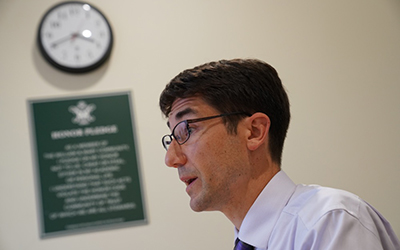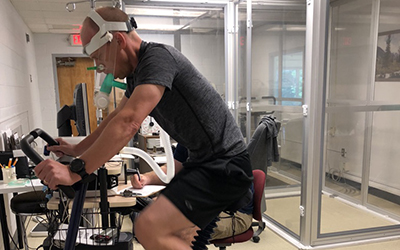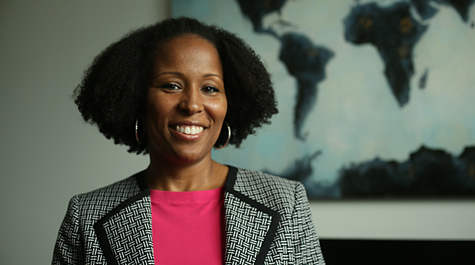From students to faculty: Alumni use their W&M experiences to teach the next generation
What’s it like to see William & Mary from both sides of the classroom — as a student and then as a faculty member? In fall 2020, there were 50 faculty members in a wide variety of departments who are also undergraduate or graduate alumni of William & Mary.
Three alumni faculty members — Daniel Maliniak ’06, Natoya Haskins Ph.D. 11 and M. Brennan Harris ’93 — shared how their experiences as W&M students influence their teaching today.
 Dan Maliniak ’06, Assistant Professor of Government and Public Policy
Dan Maliniak ’06, Assistant Professor of Government and Public Policy
Maliniak feels like he has come full circle. His journey to becoming a William & Mary professor began with a situation familiar to many students this year — a pandemic interrupted his travel plans.
He was supposed to teach English in Vietnam during the summer between his freshman and sophomore years. Unfortunately, the SARS outbreak in southeast Asia prompted a travel ban. He went back to the professors who had given him letters of recommendation for the program to let them know.
“My econ professor asked me if I had any interest in staying at W&M over the summer and doing research,” he said. “I thought, ‘I’m a freshman; I don’t really know what research is or how I could be helpful, but sure!’”
He found himself working with Economics Professor Sarah Stafford (now also chair of the department) and another alumnus, Government Professor Mike Tierney ’87, M.A. ’88 (now the George & Mary Hylton Professor of International Relations and co-director of the Global Research Institute). He became a double major in economics and government and continued doing research semester after semester.
“That summer changed everything. I realized all the incredible opportunities research could bring,” he said. “I thought it was really interesting and inspiring to add to what we knew about the world — to stand on the shoulders of giants.”
As Maliniak’s graduation neared, Tierney encouraged him to consider a Ph.D. and perhaps become a professor. Maliniak went on to graduate school at the University of California, San Diego, then started applying for faculty jobs — and found his way back to where his love of research all began.
This semester, he’s co-teaching Introduction to Environmental Science and Policy with Doug DeBerry M.A. ’89, Ph.D. ’06, another W&M alumnus who is now a visiting assistant professor. He’s also teaching Global Environmental Governance. Both his classes are remote synchronous this semester, and his students are tuning in from all over the world.
He’s continuing a wide variety of research projects with students and postdocs, including looking at racial gerrymandering, the public’s perception of environmental science issues and the promotion of democracy in the country of Georgia.
Maliniak’s experience as a W&M undergraduate showed him just how important one-on-one interactions with professors can be in a student’s life. He serves as a first-year advisor and enjoys the opportunity to encourage students to take classes that he himself took as an undergraduate, sometimes with the same professors he had as a student.
It also showed him the importance of including students who may not have a 4.0 GPA in research.
“I know the high quality of William & Mary students, so when I started teaching here I knew I could jump right into research with them,” he said. “Students who may not perform well on exams can shine in a lab or social science setting. I’ve tried to recruit students into my research from a range of disciplines and learning styles to make sure they have these opportunities.”
Natoya Haskins Ph.D. ’11, Associate Professor, School of Education
After growing up in Williamsburg, Haskins wanted to go a little farther from home for her undergraduate degree. She received her Bachelor of Science from James Madison University, then continued on to Virginia Commonwealth University and Virginia Union University for two master’s degrees.
When it came time to get her Ph.D., though, she knew she wanted to come back to William & Mary for its strong counselor education program.
“I was the only Black student in my cohort. In some ways, it was challenging, but it also allowed me to build a foundation as an expert in my subject area and break new ground,” she said. “It’s been a great opportunity to be able to come back home and give back to my program and my community.”
Haskins’ research focuses on the experiences of underrepresented students and faculty in counselor education. Drawing from her research and her own experience teaching at both the University of Georgia and William & Mary, she is continually looking for ways to support fellow Black women students, postdocs and faculty. For example, this October, she is launching a virtual affinity group for Black doctoral students nationwide.
“We still have so much work to do to support our underrepresented faculty at research institutions,” she said. “It continues to be part of my journey and the work I do.”
This semester, Haskins is teaching Advanced Theories and Qualitative Methods classes for doctoral students and an internship class for masters’ students. She also teaches Advanced Social Justice and Multicultural Counseling for doctoral students, which is a course she created and is now a requirement for the counselor education program.
“It’s one of those things that I wish I’d had when I was a doc student,” she said. “Being able to come in and add to the educational experience has been one of the most rewarding pieces of coming back.”
Haskins also directs the Social Justice and Diversity Graduate Research Fellows program, which supports and provides mentorship for graduate students conducting research in the areas of social justice and diversity.
“This particular area of research is sadly one that tends to be marginalized, minimized and sometimes even invalidated as a rigorous type of research,” Haskins said. “So, we provide training and a supportive community for our students, and we bring in outside experts who are doing this type of research to share their perspectives.”
This year, with the national spotlight focused on racial injustice nationwide, Haskins received more applications than ever from both white and underrepresented students who are interested in pursuing social justice research. And, as the pandemic moved classes and activities online, she also has been able to involve more nontraditional students, including those enrolled in online-only programs.
She’s found her discussions with students are just as rich in an online environment.
“Racial issues are something that we’re talking about just about every class,” she said. “At this point it feels very natural, just talking about things that are happening around us, the impact that it has on us and our clients. At the department level, too, we’re having courageous conversations, and those spill over into our classrooms.”
She also represents her fellow faculty members on the Faculty Assembly, where she says the “tough conversations” about diversity and equity continue.
“I’ve been heartened to see how President Katherine Rowe has really pushed the envelope in addressing diversity among the faculty, and I’m excited to see who we become over the next five to 10 years,” she said. “We are becoming it, not just saying it.”
 Brennan Harris ’93, Class of 1955 Term Distinguished Associate Professor of Health Sciences
Brennan Harris ’93, Class of 1955 Term Distinguished Associate Professor of Health Sciences
Harris jokes that after growing up in Kansas and touring colleges in cold climates, William & Mary was the warmest and best choice for his undergraduate education.
It certainly worked out — at William & Mary, he discovered his passion for kinesiology, met and married his wife, Terri Hamlett Harris ’93, and embarked on a career inspiring the next generation of students.
He got off to a bit of a rocky start, though, training for triathlons instead of focusing on classes for his physics major. His advisor, Professor Hans von Baeyer, encouraged him to consider classes in what was then the physical education department and then changed to kinesiology his sophomore year (now health sciences). Harris ignored him until the second semester of his sophomore year, when he took a kinesiology class with Professor John Charles. Harris was hooked — so much so that he changed his major to kinesiology and decided to go to graduate school in the subject.
“My undergrad advisor in kinesiology was Professor Ken Kambis, who just retired this year. Before I graduated W&M, I asked him, ‘You have a great job. What do I have to do to get your job?’ He told me to pursue the best research and the best academics, and he continued to advise me every step of the way,” Harris said.
After a master’s from University of North Carolina at Chapel Hill, a Ph.D. from the University of Texas at Austin and then postdoc in vascular biology at the Medical College of Georgia, Harris was hired into William & Mary’s faculty.
Now, he teaches Exercise Physiology, a class he took over about 15 years ago from his recently retired mentor, Kambis.
“I felt really well prepared for my masters because of Ken’s course,” Harris said. “So I teach this course like a master’s level class at other universities. Our students do us proud when they go on to their next steps.”
He also teaches a first-year seminar titled “Physiology of the Marathon”, which is a writing-intensive course in the COLL Curriculum. As a student, he was in the pilot program for those seminars, and he saw firsthand how they can give students the tools they need to be successful in their educations.
“I don’t enjoy writing; I’d much prefer to be moving,” he said. “I know there are students like me at William & Mary today, so I thought, ‘How can I reach them?’ So I made my topic the physiology of the marathon … something they wouldn’t mind thinking and reading about, so they want to write.”
One of his freshman seminar professors was George Greenia from the modern languages department, with whom Harris now works on research about the physical effects of walking pilgrimages through the Institute of Pilgrimage Studies.
Harris is also the principal investigator of the Molecular & Cardiovascular Physiology Laboratory at William & Mary and continues to collaborate with Kambis at the Jack Borgenicht Hypoxia/Altitude Physiology Research Facility. Although human subject research is on hold during the pandemic, he continues to work with students on background research, planning and grant writing.
Over time, Harris has seen the his department transition from kinesiology to health sciences expanding its focus on nutrition and public health, as well as increase research opportunities for students. He is thankful to be part of it.
“My wife and I, we love it here. We are glad we had the opportunity to come back,” he said. “W&M represents the sweet spot between doing research and teaching.”















